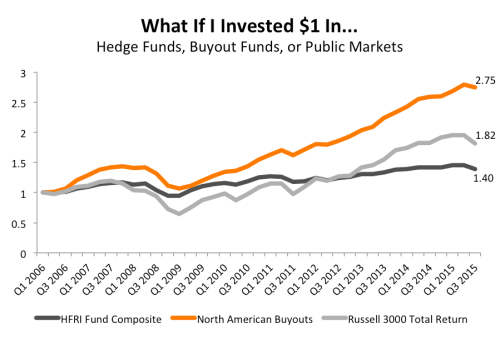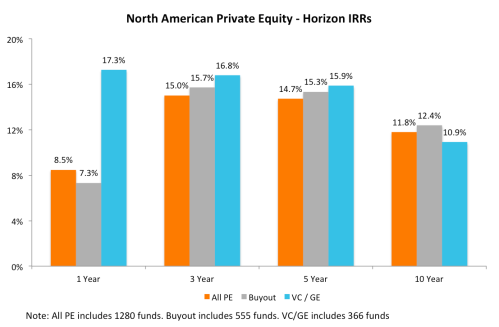For funds that are not fully exited, the net asset value (“NAV “) is the primary component of its total value. This means the NAV plays a critical role in determining a fund’s performance metrics (TVPI multiple and IRR). It is the sum of each portfolio company’s NAV and these values are determined by the GP. As a result, it is important to understand how a GP values their portfolio companies and the accounting standards that guide this process.
At the gross cash flow level, this includes the value of the GP’s equity ownership stake in each portfolio company that has not been sold. At the net cash flow level, this includes: (1) the value of the GP’s equity ownership stake in each portfolio company that has not been sold and (2) the amount of carried interest that has been accrued by the manager given the fund’s current value.
Technically speaking there is a hierarchy, broken up into three levels, that GPs must follow when they value companies. The hierarchy below has been paraphrased from the FASB’s “Fair Value Measurements and Disclosures (Topic 820)”:
Level 1 – Investments must be valued using objective, observable, unadjusted quoted market prices for identical investments in active markets on the measurement date, if available.
Level 2 –
- Objective, observable quoted market prices for similar investments in active markets.
- Quoted prices for identical or similar investments in markets that are not active.
- Inputs other than quoted prices that are observable for the asset.
- Inputs that are derived principally from or corroborated by observable market data by correlation or other means.
Level 3 – Subjective unobservable inputs for the investment where markets are not active at the measurement date. Unobservable inputs reflect the firm’s own assumptions about the assumptions that market participants would use in pricing the investment and should be developed based on best information available under the circumstances. The entity’s own data shall be adjusted if information is reasonably available without undue cost and effort that indicates that market participants would use different assumptions.
In short, the majority of private equity portfolio companies are considered “Level 3” assets because they are illiquid assets that are only valued on a quarterly basis. As a result, companies can be valued by using a combination of factors that are ultimately subject to the GP’s discretion. The exception to this “rule” is when a GP exits a company via the public markets and holds publicly listed stock. Those assets will be “Level 1” assets.
A Deeper Dive into Level 3 Assets
Since there is considerable leeway with valuing Level 3 assets, I will discuss the most common methodologies used by GPs: industry comparables, precedent transactions, and the discounted cash flow (“DCF”) method.
Industry Comparables Method
The industry comparables method seeks to find publicly listed companies whose business operations either fully or partially match the business operations of the company being evaluated. Comparable companies are initially filtered by geography and sector. From there, GPs will look to narrow down the peer set further using either revenue, EBITDA or enterprise value (“EV”) metrics. For example, if I am valuing a company with an EV of $300 million, it is more appropriate to compare it to companies of a similar size rather than a company that has an EV of $4 billion.
Once GPs have a comp set, they will find the average EV/EBITDA multiple and use that multiple as the basis for valuing their company. Depending on company metrics, GPs may make adjustments to the multiple higher or lower. Factors that could impact this include higher (or lower) historical revenue or EBITDA growth, higher (or lower) forecasted revenue or EBITDA growth, higher (or lower) EBITDA margins, higher (or lower) debt levels, and company size relative to the comps. These are the most common factors and offer a sense of possible areas where subjectivity could come into play.
Precedent Transactions Method
Precedent transactions are recent acquisitions that have occurred of similar companies. GPs will use the valuation metrics (EV/EBITDA or EV/revenue) to value their companies. This data can be difficult to find and is often limited to transactions of public companies. The other common issue with this method is that valuation information is often stale because precedent transactions occurred several years earlier when market conditions were different. Generally speaking, precedent transactions that have occurred within in the last year are considered to be valid data points.
DCF Method
The discounted cash flow methodology uses a GP’s cash flow model to estimate the company’s value. This is the most subjective method and has a tendency to be viewed with skepticism whenever it is used. That is because you are relying on the GP’s estimates for a large number of inputs, including revenue growth, EBITDA growth, and EV/EBITDA multiples and the discount rate. A slight adjustment to any one of these factors could have a meaningful impact on a company’s valuation.
When a GP uses a DCF model to value a company, it is important to understand why they are doing this and what assumptions they are using. At Bison and from my prior fund of funds days, I have not seen a DCF model used by itself very often. Sometimes, a GP will use this alongside the industry comparables methodology. In this situation, they will assign a weighting (ex. 50/50 or 75/25) to the valuation generated by the industry comps method and the DCF method.
Wrapping Up
Knowing how a GP calculates the NAV helps inform your opinion about the validity of the fund’s performance metrics but it can also offers insights into the GP’s character – are they fair and honest; do they have a tendency to be aggressive; or maybe they are slow to adjust to a changing situation. From an LP perspective, make sure to ask the right questions – how and why are you valuing your companies in this way? From a GP’s perspective, make sure that you are consistent and transparent about your valuation process. Nothing raises red flags more than dramatically changing your methodology or shrouding your process in secrecy.













